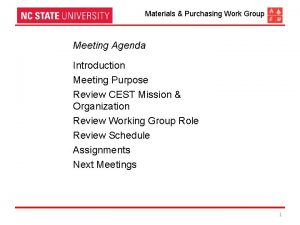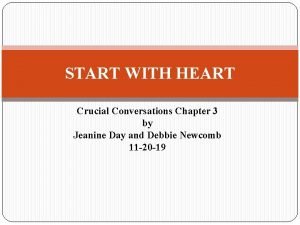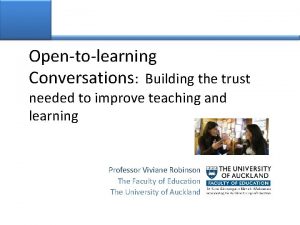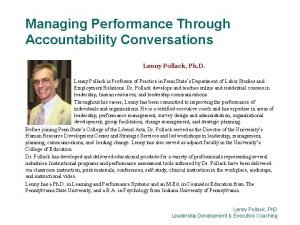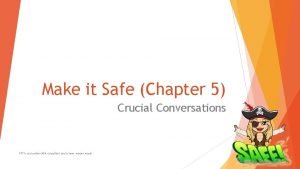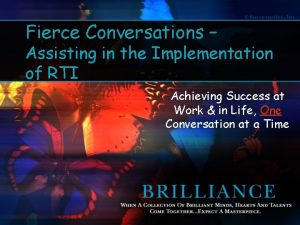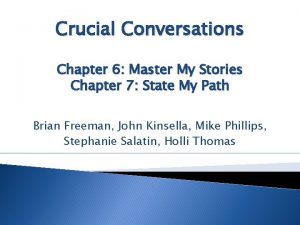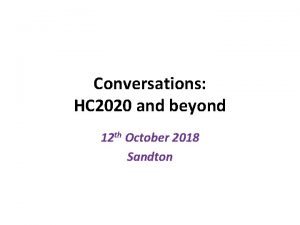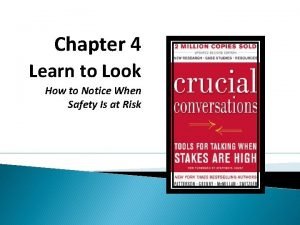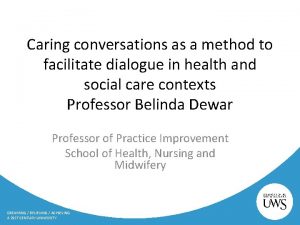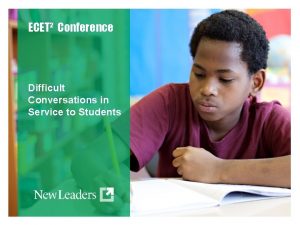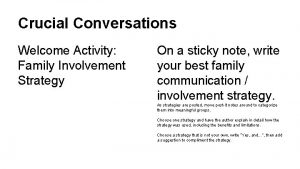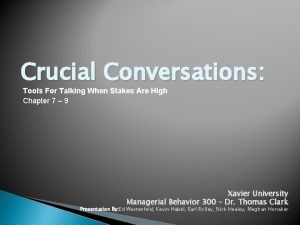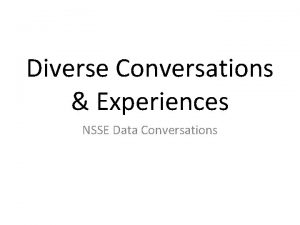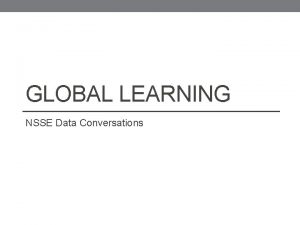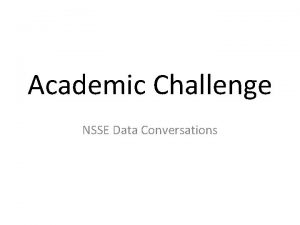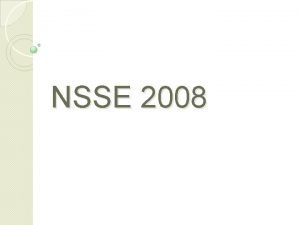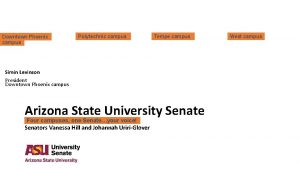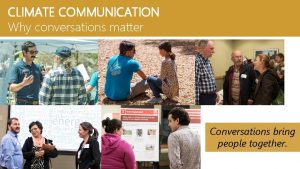Campus Environment NSSE Data Conversations Agenda Introduction to




















- Slides: 20

Campus Environment NSSE Data Conversations

Agenda • • • Introduction to NSSE Centrality of Students Overview Data Quality of Interactions Data Supportive Environment Data Discussion & Recommendations

NSSE • • Student engagement First-Year and Senior students (Spring 2016) 26% overall response rate Benchmarked against “True Peers” YSU NSSE Overview Webinar: http: //cms. ysu. edu/administrative-offices/assessment/nsse-2016

YSU’s PEER Comparison Group Carnegie Classification Pell Recipient % Part-Time Enrollment % Instructional Expenditures per FTE Undergraduate Enrollment ACT Scores of Incoming Students Living On-campus % First Generation % Total Enrollment Spent Budget on Research % Austin Peay State University California State University, Fresno California State University-Chico Cleveland State University Eastern Michigan University Indiana University. Purdue University Fort Wayne Jacksonville State University Kean University Lamar University Mc. Neese State University Middle Tennessee State University Northeastern State University Northern Kentucky University Sam Houston State University Southeastern Louisiana University Southern Oregon University Texas A&M University – Commerce Texas A&M University – Corpus Christi The University of Texas at Tyler University of Akron University of Central Oklahoma University of Memphis University of Michigan-Flint

Centrality of Students “We are a student-centered institution committed to the education, development, well-being and success of students of all ages and from all walks in life…. We strive to foster their personal, social, emotional, and career growth, as well as their capacities for lifelong learning, civic responsibility, and leadership. ” YSU CORE VALUES

Campus Environment First-Year Students YSU Peers Quality of Interactions 41. 3 40. 7 Supportive Environment 35. 2 35. 9 YSU Peers Quality of Interactions 42. 5 Supportive Environment 31. 3 32. 2 Senior Students No statistical significant difference between peers 60 point scale

Multi-Year Analysis Campus Environment First-Year 2013 Senior 2016 2013 2016 Quality of Interactions 40. 8 h 41. 3 40. 8 h 42. 5 Supportive Environment 33. 7 h 35. 2 30. 3 h 31. 3 Top-Performing NSSE Schools 2016* Campus Environment First-Year Senior YSU Top 50% Top 10% Quality of Interactions 41. 3 44. 1 45. 9 42. 5 45. 3 46. 9 Supportive Environment 35. 2 39. 2 40. 9 31. 3 35. 7 38. 1 *Statistically significant difference between all top-performing indicators

Quality of Interactions (First-Year) First-Year 2013 First-Year 2016 + 7% 47% 54% Students 48% 45% Academic Advisors 52% 50% 49% 46% Faculty Student Services Staff 42% 44% Other Staff * Percentage rating their interactions a 6 or 7 (on a scale from 1="Poor" to 7="Excellent“)

Quality of Interactions (Senior) Senior 2013 Senior 2016 + 9% 60% 59% 57% 59% 44% 47% Students + 10% Academic Advisors 47% 38% Faculty Student Services Staff 46% 36% Other Staff * Percentage rating their interactions a 6 or 7 (on a scale from 1="Poor" to 7="Excellent“)

Quality of Interactions (First-Year) % of students rating their interactions a 1, 2, or 3 (on a scale from 1="Poor" to 7="Excellent“) First-Year 2013 First-Year 2016 - 4% 12% 11% Students 18% 20% Academic Advisors 12% 13% Faculty 19% 17% Student Services Staff 22% 18% Other Staff

Quality of Interactions (Senior) % of students rating their interactions a 1, 2, or 3 (on a scale from 1="Poor" to 7="Excellent“) Senior 2013 Senior 2016 - 7% 24% 21% 8% 7% Students 19% 7% Academic Advisors 9% Faculty 22% 12% Student Services Staff 18% Other Staff

Supportive Environment – First Year % responding "Very much" or "Quite a bit" about how much the institution emphasized… First Year 2016 First Year 2013 Providing support to help students succeed academically 75% 72% Using learning support services 79% 73% Encouraging contact among students from different backgrounds 58% 50% Providing opportunities to be involved socially 70% 60% Providing support for your overall well-being 67% 60% Helping you manage your non-academic responsibilities 41% 38% Attending campus activities and events 64% 52% Attending events that address important social economic or political issues 43% 42%

Supportive Environment – First Year % responding "Very much" or "Quite a bit" about how much the institution emphasized… First Year 2016 Providing support to help students succeed academically 75% Using learning support services 79% Encouraging contact among students from different backgrounds 58% Providing opportunities to be involved socially 70% Providing support for your overall well-being 67% Helping you manage your non-academic responsibilities 41% Attending campus activities and events 64% Attending events that address important social economic or political issues 43% First Year 2013 +3 +6 +8 +10 +7 +3 +12 +1 72% 73% 50% 60% 38% 52% 42%

Supportive Environment - Senior % responding "Very much" or "Quite a bit" about how much the institution emphasized… Senior 2016 Senior 2013 Providing support to help students succeed academically 69% 71% Using learning support services 68% 66% Encouraging contact among students from different backgrounds 50% 47% Providing opportunities to be involved socially 65% 56% Providing support for your overall well-being 59% 56% Helping you manage your non-academic responsibilities 27% 23% Attending campus activities and events 50% 43% Attending events that address important social economic or political issues 35% 39%

Supportive Environment - Senior % responding "Very much" or "Quite a bit" about how much the institution emphasized… Senior 2016 Senior 2013 Providing support to help students succeed academically 69% -2 71% Using learning support services 68% +2 66% Encouraging contact among students from different backgrounds 50% +3 47% Providing opportunities to be involved socially 65% +9 56% Providing support for your overall well-being 59% +3 56% Helping you manage your non-academic responsibilities 27% +4 23% Attending campus activities and events 50% +7 43% Attending events that address important social economic or political issues 35% -4 39%

Transfer Status 3, 17 3, 08 Started at YSU 3, 01 2, 85 Spending a Providing Support to significant amounts help students of time on academic succeed work academically *4 point scale Transfer 3, 05 2, 82 Using Learning Support Services Q: How much does the institution emphasize? 2, 61 2, 48 Encouraging contact among student from Different Backgrounds Transfer Student n = 190 & Non-Transfer student n = 736

Transfer Status 2, 87 2, 73 Started at YSU 2, 78 2, 66 2, 63 2, 13 Q: How much does the institution emphasize? Transfer 2, 43 2, 18 1, 83 Providing Support Helping You Attending Events Opportunities to for Your Overall Manage Your Non Campus Activities that Address Be Involved Well-Being -Academic and Events Important Social, Socially Responsibilities Economic, or Political Issues *4 point scale Transfer Student n = 190 & Non-Transfer student n = 736

Age Breakdown 19 or Younger 20 -23 24 -29 30 -39 40 -55 Q: How much does the institution emphasize? 2, 79 2, 63 Attending Campus Activities and Events 2, 35 2, 36 2, 44 2, 3 Helping You Manage Your Non-Academic Responsibilities 2, 07 1, 84 1, 75 1, 78 *4 point scale 19 or younger n = 343, 20 -23 n = 315, 24 -29 n = 118, 30 -39 n = 84, 40 -55 n = 50

Residence Status On-Campus 2, 82 2, 71 Within Walking Distance Beyond Walking Distance 2, 78 2, 74 2, 18 2, 11 2, 59 2, 57 2, 01 Q: How much does the institution emphasize? Providing Support for Your Helping Your Manage your Overall Well-Being Non-Academic Responsibilities *4 point scale Attending Campus Activities and Events On-Campus n = 117, Within Walking Distance n = 92, & Beyond Walking Distance n = 649

Discussions & Recommendations 1. What trend(s) did you notice in the data broken down by transfer status, age, or residence status? What areas can we target to close the gap between student populations? 2. Between 2013 and 2016, significant gains have been made in the Campus Engagement areas. What do you think caused the increase? 3. What recommendations do you have to ensure continued growth in both students’ quality of interactions and feelings that YSU provides a supportive environment?
 Agenda sistemica y agenda institucional
Agenda sistemica y agenda institucional Financial environment of business
Financial environment of business Channel partner meeting agenda
Channel partner meeting agenda Meeting agenda introduction
Meeting agenda introduction Agenda for mentor meeting
Agenda for mentor meeting Start with heart
Start with heart Crucial conversations quiz
Crucial conversations quiz Open to learning conversations viviane robinson
Open to learning conversations viviane robinson Accountable conversations
Accountable conversations Difficult conversations ppt
Difficult conversations ppt Fierce conversations 7 principles
Fierce conversations 7 principles Talk tentatively
Talk tentatively Crucial conversations chapter 6 summary
Crucial conversations chapter 6 summary Crucial conversations state my path
Crucial conversations state my path Chapter 6
Chapter 6 Fierce conversations 7 principles
Fierce conversations 7 principles Crucial conversations learn to look
Crucial conversations learn to look Caring conversations framework
Caring conversations framework Difficult conversations role play
Difficult conversations role play Crucial conversations role play exercises
Crucial conversations role play exercises Ampp crucial conversations
Ampp crucial conversations



